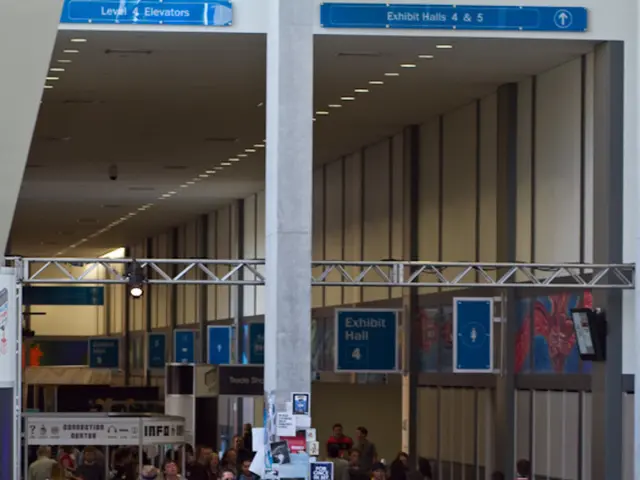Runway End Safety Area (RESA): Importance and Compliance with ICAO Standards
RESA: A Runway's Life-Saving Safety Zone
In the high-flying world of aviation, safety is an unwavering priority - and the Runway End Safety Area (RESA) is a pivotal component, designed to protect aircraft and passengers in emergencies like overruns or aborted takeoffs. Although often overlooked, the significance of RESAs cannot be understated as they play a crucial role in reducing damage and loss.
The International Civil Aviation Organization (ICAO), a global aviation authority, sets guidelines to ensure uniform safety standards worldwide. According to ICAO, every international airport must boast a RESA at each runway end, with cellular phone towers and other structures forbidden within these zones.
What's a RESA?
The RESA (Runway End Safety Area) is an essential safety buffer, extending beyond the aircraft's runway strip. Designed to absorb impact, it shields both passengers and aircraft during emergencies, albeit it's not built for routine use. Instead, it serves as an essential platform for emergency vehicles or aircraft unable to stop on the runway.
ICAO RESA Requirements: Dimensions and Design
ICAO offers guidelines on RESA dimensions and designs in their Annex 14 - Aerodromes.
- Length: At the very least, a RESA should stretch 90 meters past the runway strip. For higher-risk operations, a 240-meter RESA is preferred, depending on the type of aircraft and operational risks.
- Width: The RESA should at least be twice as wide as the runway itself.
Keep in mind, ICAO suggests 240 meters for higher-risk operations, but insists on a minimum of 90 meters. Some national aviation authorities, such as the FAA (U.S.), impose more stringent regulations and mandate a 305-meter RESA for specific commercial operations.
RESA vs. EMAS: What's the Difference?
When constructing a RESA is impossible due to terrain or urban constraints, an alternative system known as EMAS (Engineered Materials Arresting System) takes center stage. EMAS, equipped with a crushable surface, is intended to halt aircraft rapidly, decelerating them safely.
- RESA: A passive safety zone, composed of grass, compacted soil, or similar materials.
- EMAS: A high-tech, active deceleration system made from engineered materials that slow down aircraft effectively.
Many major airports, including JFK, Madrid, and Chicago O'Hare, use EMAS instead of a traditional RESA due to space limitations.
Why Every Runway Needs a RESA
A RESA designed according to ICAO's guidelines:
- Saves lives by offering a safe zone during emergencies.
- Minimizes aircraft damage and reduces operational disruptions.
- Ensures airport compliance with ICAO and national safety standards.
- Supports rescue operations and post-accident investigations.
Real-Life Incidents Highlighting RESA's Importance
History has shown the consequences of poorly designed or non-existent RESAs.
- Air France Flight 358 (Toronto, 2005): An Airbus A340 overshot the runway and ended up in a ravine. A longer RESA may have prevented extensive damage.
- Overruns at Congested Airports: Many regional airports lack sufficient RESAs, increasing the risk of damage or fatalities during excursion events.
Design Considerations for RESA
- A sturdy foundation is crucial for supporting emergency vehicles.
- Mild slopes and grading minimize additional damage in overruns.
- An unpaved surface, usually grass, sand, or stabilized soil, is best.
- The zone should be obstacle-free, devoid of any structures or lighting equipment.
Why Every Runway Needs RESA
Sure, it's invisible to most passengers, but the Runway End Safety Area (RESA) is crucial to runway design and plays a significant role in aviation safety. Adherence to ICAO's standards isn't just about compliance; it's a life-saving measure. As air traffic continues to grow, particularly in densely populated or geographically confined airports, designing proper RESAs and alternatives like EMAS will become increasingly critical.
FAQ About RESA
- Q1: Is RESA mandatory at all airports? A: ICAO requires an RESA on international runways, though some countries enforce stricter local regulations.
- Q2: Can an aircraft stop in RESA safely? A: An RESA isn't paved, but it's designed to minimize damage during emergencies.
- Q3: What happens if an airport lacks space for RESA? A: In such cases, EMAS can be utilized as an ICAO-approved alternative.
Keywords: RESA, Runway End Safety Area, ICAO runway standards, airport safety zones, overrun protection, aircraft safety area
Recommended Reading: https://tc.canada.ca/en/aviation/reference-centre/advisory-circulars/advisory-circular-ac-no-302-015
- In the aviation industry, the International Civil Aviation Organization (ICAO) has set guidelines to ensure uniform aviation safety standards worldwide, requiring every international airport to have Runway End Safety Areas (RESA) at each runway end, as these areas play a crucial role in reducing damage and loss during aviation incidents like overruns or aborted takeoffs.
- The Transportation sector recognizes the significance of finance in the development and maintenance of safety-critical infrastructure, such as aviation. In particular, ensuring that each runway features a Runway End Safety Area (RESA) as per ICAO's recommendations is a vital investment not only for meeting safety standards but also for saving lives and minimizing operational disruptions in aviation.
- In light of the technological advancements and increasing air traffic, particularly in densely populated or geographically confined airports, investing in Runway End Safety Areas (RESA) or its alternatives, like Engineered Materials Arresting Systems (EMAS), becomes crucial for maintaining aviation safety and addressing the growing demand for transportation in the industry.








